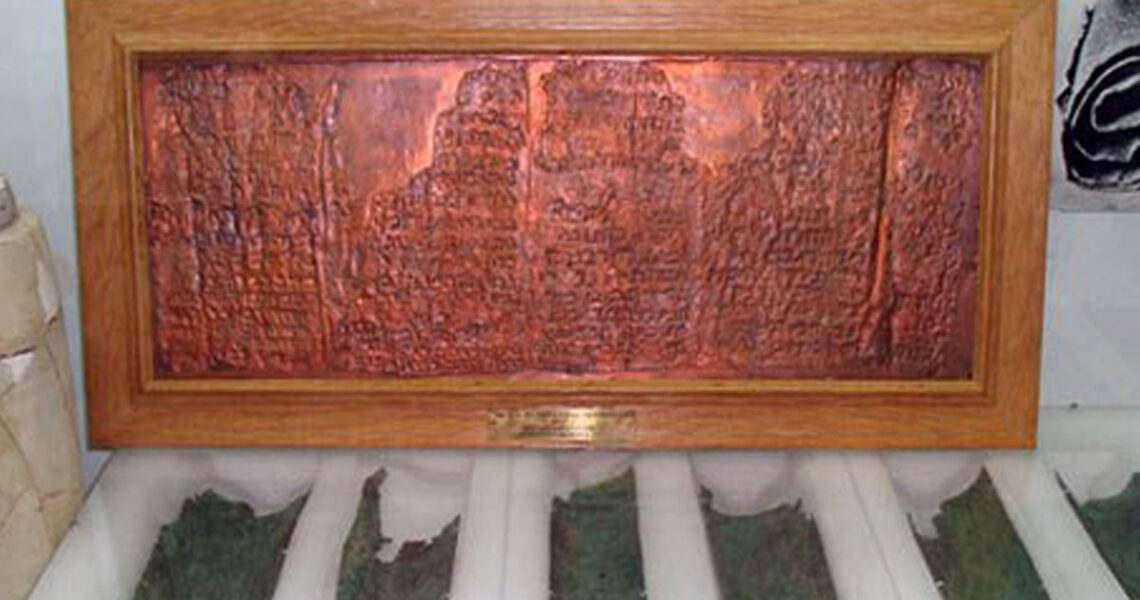The Dead Sea Scrolls are ancient Jewish manuscripts that were found in the Qumran Caves in the dessert to the north of the Dead Sea. The Copper Scroll is one of the most famous scrolls because it is the only metal scroll and it lists places were various items of gold and silver are hidden. It is made of copper so thin that it could be rolled up but, due to corrosion, the scroll had to be cut into strips for preservation purposes and is now on displayed at the Jordan Museum.
History: While most of the Dead Sea Scrolls were found by Bedouins, the Copper Scroll was discovered by an archaeologist. The scroll, on two rolls of copper, was found on March 14, 1952 at the back of Cave 3 at Qumran. It was the last of 15 scrolls discovered in the cave, and is thus referred to as 3Q15. The corroded metal could not be unrolled by conventional means and so the Jordanian government sent it to Manchester University’s College of Technology in England on the recommendation of English archaeologist and Dead Sea Scrolls scholar John Macro Allegro for it to be cut into sections, allowing the text to be read. He arranged for the university’s Professor H. Wright Baker to cut the sheets into 23 strips in 1955 and 1956. It then became clear that the rolls were part of the same document. Allegro, who had supervised the opening of the scroll, transcribed its contents immediately. Scholarly estimates of the probable date range of The Copper Scroll vary. F.M Cross proposed the period of 25–75 CE on palaeographical grounds, while W.F Albright suggested 70–135 CR and Manfred Lehmann put forward a similar date range, arguing that the treasure was principally the money accumulated between the First Jewish Roman War and the Bar Kokhbha Revolt, while the temple lay in ruins. David Wilmot and Judah Lefkovits all agree that the scroll originated around 70 CE. Whereas Emile Puech argued that the deposit of the Copper Scroll behind 40 jars could not have been placed after the jars, so the scroll predates 68 CE. Some scholars believe that the difficulty in deciphering the text is perhaps due to it having been copied from another original document by an illiterate scribe who did not speak the language in which the scroll was written, or at least was not well familiar. As Milik puts it, the scribe uses the forms and ligature of the cursive script along with formal letters, and often confuses graphically several letters of the formal hand. As a result, it has made translation and understanding of the text difficult.
Mystery behind Copper scroll treasure: The Copper Scroll led to one of the biggest treasure hunts in history with numerous expeditions that have already attempted to find the treasure it describes. However, the clues to were the treasure is are written in such obscure ways that any treasure hunter will have a hard time working it out. For example, one column reads that In the salt pit that is under the steps: forty-one talents of silver. In the cave of the old washer’s chamber, on the third terrace sixty-five ingots of gold. As no real starting point is mentioned, it would also be impossible to follow all the directions accurately. Scholars also think that some of the treasure could have been taken thousands of years ago by the Romans or other looters. One extensive treasure hunt occurred in 1962 when archaeologist John Allegro excavated potential burial places that were listed on the scroll. Unfortunately he came back empty handed but that didn’t stop other treasure seekers following his lead. Due to the current political situation in the region were the scrolls were found, it’s very difficult to get permission to do any serious excavation work. However, this could mean that the treasure is still out there somewhere, waiting to be found.
Copper Scroll contents: It was no ordinary list, rather it contained directions to 64 locations where staggering quantities of treasure could be found. Sixty-three of the locations refer to gold and silver, which have been estimated in the tonnes. Tithing vessels are also listed among the entries, along with other vessels, and three locations scrolls. One entry apparently mentions priestly vestments. In total, over 4,600 talents of precious metal are listed on the scroll, making the total haul worth in excess of a billion dollars. The treasure of the scroll has been assumed to be treasure of the Jewish Temple. Some scholars have claimed it belonged to the First temple, destroyed by Nebuchadnezzar, King of Babylon, in 586 BC. However, the scroll has been dated to between 25 AD and 100 AD which suggests that this hypothesis is unlikely. Other experts have suggested that the treasure could be that of the second temple. However, historical records suggest that the main treasure of the Temple was still in the building when it fell to the Romans. It does not rule out this possibility though a significant portion of the treasures may have been taken away and hidden before the Romans arrived.
Thus, a treasure has yet to be found. Even if none of the treasures comes to light, 3Q15, a new, long ancient Hebrew text has significance. However, for the wise, the Copper Scroll is little more than what scholars have claimed since the beginning.
